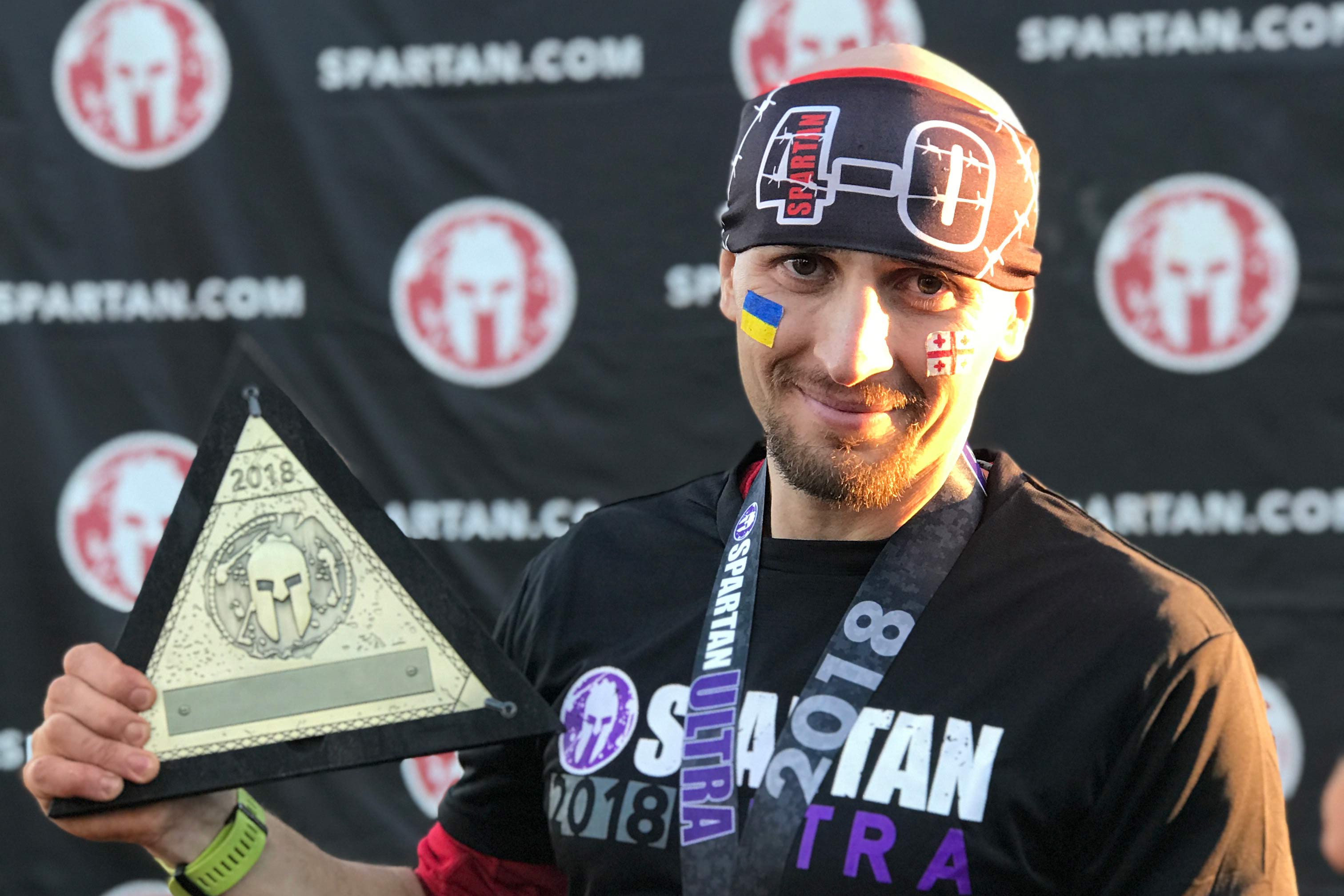A Day in the Life of Spartan Pro Lefty Kapanadze

How do elite Spartans optimize their days? When do they wake up and go to sleep, what do they eat, how do they train, how do they stay centered, and how do they balance life and work? We've been asking these questions for years, and now we have the answers. In Spartan Day in the Life, our highest-performing athletes and coaches share the daily routines that make them unbreakable.
Unlike many elite ultra-endurance Spartan types, Lefty Kapanadze doesn’t wake up, gulp coffee, and charge out the door into a morning workout. It’s actually the opposite: He finds the idea of working out in the morning borderline insane.
“When I’m driving to work at seven in the morning and I see people out for a run, I think: What are you doing? Why aren’t you in bed sleeping?” he says. “When I wake up, I go to work. I hate training in the first half of the day. I hate it. I just don’t do it.”
After work, however, it’s an entirely different story for Kapanadze. In fact, he's kind of a story-creating machine, when circumstances present themselves as an opportunity to see just how far he can push his body with his mind.
Related: How to Unleash Your Inner Spartan If You Work at a Desk All Day
Take, for example, a few years ago, when a day at his Washington, D.C., construction job turned surreal and he had to mix 360 bags of concrete by hand because there was no machine mixer.
“I worked 10 hours," he says. "I mixed the concrete with a shovel — six pallets worth.”
Because of the job's time extension, the construction worker was left at the site — hours from home — with no car to get there. An exhausted Kapanadze dialed a friend to ask for a ride, but it would take two hours for his friend to drive to D.C. and then it would be another 90 minutes for his friend to drive him home.
Forget that, Kapanadze thought, another idea already taking shape in his head.
"How the hell are you going to get home?" his friend asked.
“I didn’t tell him I was going to run,” Kapanadze says.
Becoming an Ultra Runner in an Unconventional Fashion

So he went to a nearby gas station, stocked up on bananas and peanut bars, and then hit the road.
It took Kapanadze six hours of running what became his first ultra-marathon, but he made it. (Although he did collapse on a bridge for a spell as a woman passing by asked, “Are you OK young man?”)
The next day, he was back on the job.
Getting There the Hard Way

Perhaps it was the illnesses he survived as a kid (sepsis, bronchitis, multiple pneumonias) and growing up in the Republic of Georgia at a time when his country was at war with Soviet communists (tanks and bodies on the streets, rampant food shortages, no heat or electricity), but today, Kapanadze seems hard-wired for sports like ultra-running and Spartan racing. In fact, it was his wife, Victoria, who (obviously knowing her husband) signed him up for his first Spartan race.
Related: My First Spartan Race Was a Beast. Here Are 5 Things I Wish I'd Known.
“While I would never want anybody to go through the kinds of hardships that I did, those harsh times made me who I am today,” the athlete says on his website.
Though he has earned podium slots at all of the classic Spartan race distances, Kapanadze continues to show a particular flair for extreme events. In true Spartan spirit, his reasoning for undertaking feats such as his running six hours after a day of stirring concrete is simply, “I just want to see where my limits are.”
Yet, there is a simplicity in how he lives each day: Get up early, eat clean, and work at a job that has a built-in measure of functional fitness training. Polishing and fixing stone requires, for one thing, lugging around 200-pound machines.
“I definitely don’t sit in an office all day,” Kapanadze says.
If you take it as a given that hard physical labor translates into an effective stream of foundational strength training, you could accurately describe Kapanadze's post-work run, bike, or strength workout as the latter half of an all-day brick workout.
Kapanadze’s Secret to Success in Spartan and Beyond

If there’s a secret to this Spartan's success, it’s consistency.
“I don’t like skipping workouts,” he says. “I always do something.”
That is, Kapanadze says, even the day after an ultra event, when he might be dealing with severe soreness from muscle damage.
Related: Eat Like Sepsis Survivor and Spartan Pro Lefty Kapanadze for a Week
“I love to ride my bike the day after an Ultra,” Lefty says. “It’s rough at first, but after a while I feel so good that I don’t want to stop. It’s active recovery.”
Periodization by the Season

Another key approach that this endurance athlete has used in the past is to apply a broad form of periodization to his training, emphasizing functional strength work in the gym or at home during the winter, and then emphasizing aerobic activity in the summer.
Related: 5 Critical Training Mistakes You Want to Avoid
“In the winter, it’s a 70/30 ratio of strength training to aerobic training,” he says. “In the summer, it’s reversed.”
Methodically Blasting His Way Through Injuries

Lefty — as the Spartan community knows him — is currently on the comeback trail after injuring his knee during a Stadion race. Despite being perhaps his worst injury since a 2010 bike accident when he damaged his sciatic nerve and was bed-ridden for a week, Kapanadze still finished the race.
Clearly, he's no stranger to overcoming setbacks caused by injury. After that gruesome bike accident, Lefty completely freaked out his doctor when he refused to take any kind of painkiller. (Mind you, this is the sciatic nerve we’re talking about, which, when inflamed, is set off like a three-alarm fire by just about any movement that the person makes.)
“I told the doctor, ‘It’s not life-threatening, so why would I take a pill?” he says.
Related: A Day in the Life of Spartan Master Coach Monique Berarducci
To the physician's horror, Lefty walked out of the hospital. But that was it for walking for nearly two weeks, until he began relearning the movement step by step. In week three, the nerve withstood an 8-mile run. Suddenly, the Spartan was on his way back to being an athlete again, all without meds.
Even so, the subsequent torn-up knee offered up a complicated problem to be solved through sheer force of will: damaged cartilage that prevented proper tracking. Lefty’s solution was methodical. He tried out every knee brace until he found one that kept things in the proper position.
And it was just in time for the reopening of the world of endurance racing, too. While he plans to restrict his competitive schedule to ultra-running as he rebuilds the strength in his knee, Lefty continues to be unstoppable and unbreakable (except for morning workouts).

